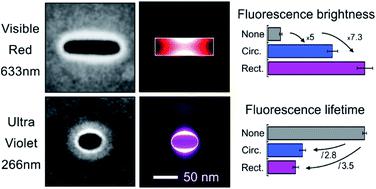当前位置:
X-MOL 学术
›
Nanoscale Adv.
›
论文详情
Our official English website, www.x-mol.net, welcomes your
feedback! (Note: you will need to create a separate account there.)
Zero-mode waveguides can be made better: fluorescence enhancement with rectangular aluminum nanoapertures from the visible to the deep ultraviolet
Nanoscale Advances ( IF 4.6 ) Pub Date : 2020-07-23 , DOI: 10.1039/d0na00366b Mikhail Baibakov 1 , Aleksandr Barulin 1 , Prithu Roy 1 , Jean-Benoît Claude 1 , Satyajit Patra 1 , Jérôme Wenger 1
Nanoscale Advances ( IF 4.6 ) Pub Date : 2020-07-23 , DOI: 10.1039/d0na00366b Mikhail Baibakov 1 , Aleksandr Barulin 1 , Prithu Roy 1 , Jean-Benoît Claude 1 , Satyajit Patra 1 , Jérôme Wenger 1
Affiliation

|
Nanoapertures milled in metallic films called zero-mode waveguides (ZMWs) overcome the limitations of classical confocal microscopes by enabling single molecule analysis at micromolar concentrations with improved fluorescence brightness. While the ZMWs have found many applications in single molecule fluorescence studies, their shape has been mainly limited to be circular. Owing to the large parameter space to explore and the lack of guidelines, earlier attempts using more elaborate shapes have led to unclear conclusions whether or not the performance was improved as compared to a circular ZMW. Here, we comparatively analyze the performance of rectangular-shaped nanoapertures milled in aluminum to enhance the fluorescence emission rate of single molecules from the near infrared to the deep ultraviolet. Our new design is based on rational principles taking maximum advantage of the laser linear polarization. While the long edge of the nanorectangle is set to meet the cut-off size for the propagation of light into the nanoaperture, the short edge is reduced to 30 nm to accelerate the photodynamics while maintaining bright fluorescence rates. Our results show that both in the red and in the ultraviolet, the nanorectangles provide 50% brighter photon count rates as compared to the best performing circular ZMWs and achieve fluorescence lifetimes shorter than 300 ps. These findings can be readily used to improve the performance of ZMWs, especially for fast biomolecular dynamics, bright single-photon sources, and ultraviolet plasmonics.
中文翻译:

零模波导可以做得更好:从可见光到深紫外的矩形铝纳米孔径增强荧光
在称为零模式波导 (ZMW) 的金属薄膜中研磨的纳米孔径通过在微摩尔浓度下进行单分子分析并提高荧光亮度,克服了经典共聚焦显微镜的局限性。虽然 ZMW 在单分子荧光研究中发现了许多应用,但它们的形状主要限于圆形。由于要探索的参数空间大且缺乏指导方针,早期使用更精细形状的尝试导致与圆形 ZMW 相比性能是否有所提高的结论尚不清楚。在这里,我们比较分析了在铝中研磨的矩形纳米孔的性能,以提高单分子从近红外到深紫外的荧光发射率。我们的新设计基于合理原理,最大限度地利用激光线偏振。虽然纳米矩形的长边设置为满足光传播到纳米孔径的截止尺寸,但短边减小到 30 nm 以加速光动力学,同时保持明亮的荧光速率。我们的结果表明,在红色和紫外线下,与性能最佳的圆形 ZMW 相比,纳米矩形提供了 50% 更亮的光子计数率,并实现了短于 300 ps 的荧光寿命。这些发现可以很容易地用于提高 ZMW 的性能,特别是对于快速生物分子动力学、明亮的单光子源和紫外等离子体。虽然纳米矩形的长边设置为满足光传播到纳米孔径的截止尺寸,但短边减小到 30 nm 以加速光动力学,同时保持明亮的荧光速率。我们的结果表明,在红色和紫外线下,与性能最佳的圆形 ZMW 相比,纳米矩形提供了 50% 更亮的光子计数率,并实现了短于 300 ps 的荧光寿命。这些发现可以很容易地用于提高 ZMW 的性能,特别是对于快速生物分子动力学、明亮的单光子源和紫外等离子体。虽然纳米矩形的长边设置为满足光传播到纳米孔径的截止尺寸,但短边减小到 30 nm 以加速光动力学,同时保持明亮的荧光速率。我们的结果表明,在红色和紫外线下,与性能最佳的圆形 ZMW 相比,纳米矩形提供了 50% 更亮的光子计数率,并实现了短于 300 ps 的荧光寿命。这些发现可以很容易地用于提高 ZMW 的性能,特别是对于快速生物分子动力学、明亮的单光子源和紫外等离子体。我们的结果表明,在红色和紫外线下,与性能最佳的圆形 ZMW 相比,纳米矩形提供了 50% 更亮的光子计数率,并实现了短于 300 ps 的荧光寿命。这些发现可以很容易地用于提高 ZMW 的性能,特别是对于快速生物分子动力学、明亮的单光子源和紫外等离子体。我们的结果表明,在红色和紫外线下,与性能最佳的圆形 ZMW 相比,纳米矩形提供了 50% 更亮的光子计数率,并实现了短于 300 ps 的荧光寿命。这些发现可以很容易地用于提高 ZMW 的性能,特别是对于快速生物分子动力学、明亮的单光子源和紫外等离子体。
更新日期:2020-09-16
中文翻译:

零模波导可以做得更好:从可见光到深紫外的矩形铝纳米孔径增强荧光
在称为零模式波导 (ZMW) 的金属薄膜中研磨的纳米孔径通过在微摩尔浓度下进行单分子分析并提高荧光亮度,克服了经典共聚焦显微镜的局限性。虽然 ZMW 在单分子荧光研究中发现了许多应用,但它们的形状主要限于圆形。由于要探索的参数空间大且缺乏指导方针,早期使用更精细形状的尝试导致与圆形 ZMW 相比性能是否有所提高的结论尚不清楚。在这里,我们比较分析了在铝中研磨的矩形纳米孔的性能,以提高单分子从近红外到深紫外的荧光发射率。我们的新设计基于合理原理,最大限度地利用激光线偏振。虽然纳米矩形的长边设置为满足光传播到纳米孔径的截止尺寸,但短边减小到 30 nm 以加速光动力学,同时保持明亮的荧光速率。我们的结果表明,在红色和紫外线下,与性能最佳的圆形 ZMW 相比,纳米矩形提供了 50% 更亮的光子计数率,并实现了短于 300 ps 的荧光寿命。这些发现可以很容易地用于提高 ZMW 的性能,特别是对于快速生物分子动力学、明亮的单光子源和紫外等离子体。虽然纳米矩形的长边设置为满足光传播到纳米孔径的截止尺寸,但短边减小到 30 nm 以加速光动力学,同时保持明亮的荧光速率。我们的结果表明,在红色和紫外线下,与性能最佳的圆形 ZMW 相比,纳米矩形提供了 50% 更亮的光子计数率,并实现了短于 300 ps 的荧光寿命。这些发现可以很容易地用于提高 ZMW 的性能,特别是对于快速生物分子动力学、明亮的单光子源和紫外等离子体。虽然纳米矩形的长边设置为满足光传播到纳米孔径的截止尺寸,但短边减小到 30 nm 以加速光动力学,同时保持明亮的荧光速率。我们的结果表明,在红色和紫外线下,与性能最佳的圆形 ZMW 相比,纳米矩形提供了 50% 更亮的光子计数率,并实现了短于 300 ps 的荧光寿命。这些发现可以很容易地用于提高 ZMW 的性能,特别是对于快速生物分子动力学、明亮的单光子源和紫外等离子体。我们的结果表明,在红色和紫外线下,与性能最佳的圆形 ZMW 相比,纳米矩形提供了 50% 更亮的光子计数率,并实现了短于 300 ps 的荧光寿命。这些发现可以很容易地用于提高 ZMW 的性能,特别是对于快速生物分子动力学、明亮的单光子源和紫外等离子体。我们的结果表明,在红色和紫外线下,与性能最佳的圆形 ZMW 相比,纳米矩形提供了 50% 更亮的光子计数率,并实现了短于 300 ps 的荧光寿命。这些发现可以很容易地用于提高 ZMW 的性能,特别是对于快速生物分子动力学、明亮的单光子源和紫外等离子体。











































 京公网安备 11010802027423号
京公网安备 11010802027423号